| Reviews & Columns |
|
Reviews DVD TV on DVD Blu-ray 4K UHD International DVDs In Theaters Reviews by Studio Video Games Features Collector Series DVDs Easter Egg Database Interviews DVD Talk Radio Feature Articles Columns Anime Talk DVD Savant Horror DVDs The M.O.D. Squad Art House HD Talk Silent DVD
|
DVD Talk Forum |
|
|
| Resources |
|
DVD Price Search Customer Service #'s RCE Info Links |
|
Columns
|
|
|
Crocodile Dundee / Crocodile Dundee II
Paramount // PG-13 // May 13, 2014
List Price: $22.98 [Buy now and save at Amazon]
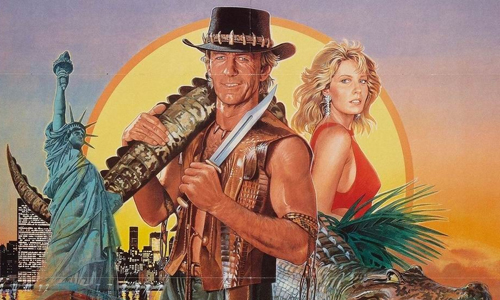
Cinema in the '80s saw several roughnecked, good-looking adventurers leading unseasoned city-dwellers to safety in the throws of danger in the wild, revealing later on that said adventurers aren't so coarse and the less wilderness-savvy folk aren't quite as incapable when push comes to shove. On the steam of the Indiana Jones films and the success of Romancing the Stone, Australian TV personality Paul Hogan introduced his own brand of weathered renegade: Mick "Crocodile" Dundee. Based on the real-life experiences of "bushman" Rodney Ansell, from his survival instincts to his discomfort in the urban jungle, Hogan takes on an impish, self-aware attitude within this mythical wanderer of the wilderness, playing up the persona with cheeky jabs at how people perceive him ... while revealing which of the fables about him are actually true. While there's little originality built around the roguish character himself, there's a certain level of charm and mild humor that's easy to enjoy while hiking around Walkabout Creek and New York City with Mick, and it's easy to see why he became such a successful box-office draw.
Crocodile Dundee:

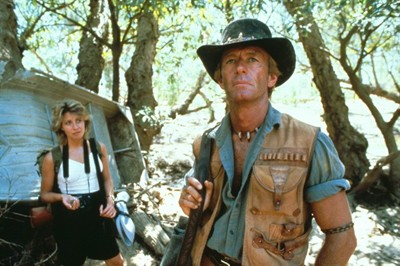 With some help in the writing department from producer John Cornell and Ken Shadie, and directed by Peter Faiman (Dutch), Paul Hogan's first Crocodile Dundee outing walks a pretty straightforward path: Sue Charlton (Linda Kozlowski), an attractive New York reporter, travels to Australia to do a human interest piece on a legendary bushman and safari guide who survived a crippling crocodile attack. When she arrives at Walkabout Creek, an off-the-radar settlement with little foot traffic, she finds out that there's more -- and less -- to his story, as Mick rowdily stumbles into a bar, little worse for wear outside of a decent scar, and merrily mingles with the locals over drinks. Skeptical, but still committed to investigating the story, Sue ventures into the Outback with Dundee to see the location of the attack, as well as to get a feel for how he does things in his backyard. Between Mick's interaction with the locals and his handling of the wildlife, she discovers that there is, in fact, some truth underneath the tall tales.
With some help in the writing department from producer John Cornell and Ken Shadie, and directed by Peter Faiman (Dutch), Paul Hogan's first Crocodile Dundee outing walks a pretty straightforward path: Sue Charlton (Linda Kozlowski), an attractive New York reporter, travels to Australia to do a human interest piece on a legendary bushman and safari guide who survived a crippling crocodile attack. When she arrives at Walkabout Creek, an off-the-radar settlement with little foot traffic, she finds out that there's more -- and less -- to his story, as Mick rowdily stumbles into a bar, little worse for wear outside of a decent scar, and merrily mingles with the locals over drinks. Skeptical, but still committed to investigating the story, Sue ventures into the Outback with Dundee to see the location of the attack, as well as to get a feel for how he does things in his backyard. Between Mick's interaction with the locals and his handling of the wildlife, she discovers that there is, in fact, some truth underneath the tall tales. While the film's tone stays lighthearted and throws in subtle gags about life in the Outback -- about eating food in the wild, dealing with trigger-happy tourists, and participation in Aboriginal rituals -- much of Crocodile Dundee plays the story relatively straight in the Australian setting. A large part of that comes in Sue's observation of the kind of man Mick Dundee really is, cutting through the bull cooked up by local tour guide Wally (John Meillon) and discovering what he can and can't do. There's even some darker material underneath, about the circumstances of the crocodile attack and how Dundee makes ends meet, that flirts with unexpected character depth. Against the expanses of the beautiful Australian wilderness that have been almost mundanely photographed to downplay the scenery's splendor, director Faiman restrains what could've easily devolved into a broad lampoon of the region's culture, where the reporter's evolving perception of this rugged not-quite Tarzan carefully shifts along with the audience's.
Crocodile Dundee becomes the embodiment of a fish-outta-water story as Sue braves the wilderness, handled really well by Linda Kozlowski as she reveals that she's tougher than she seems to prove her companion wrong, and that ends up going both ways once Dundee travels to the city. From the second he steps off the plane, the film transitions into a more overt comedy about his lack of exposure to city living, where his subtle adventure through the urban jungle -- in fancy hotels, fine restaurants, and upscale parties -- keeps a steady stream of amusement without landing any hearty laughs. There are silly moments that stretch the limits of believability, sure, but Hogan's natural charisma does such a great job of mixing the character's aloofness and awareness of his foreign surroundings that it really doesn't matter. The back-and-forth clashing of cultures becomes just enough of a backdrop for Crocodile Dundee's corniness and burgeoning romance to squeak by as an enjoyable experience, and a fondly-memorable relic from the '80s.
Crocodile Dundee II:

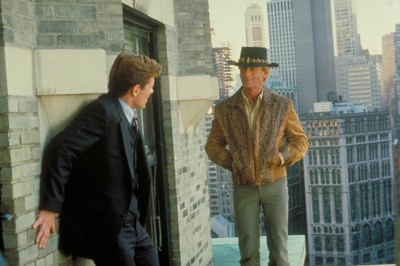 Crocodile Dundee II fumbles in two critical areas when it comes to developing a sequel: it tries too hard to raise the stakes above the first film's successful formula, and it cashes in too hard on the audience's fondness for the original. There's a simpler story that Paul Hogan almost tells here, about Mick Dundee's homesickness while living in the city (with Sue) and his inevitable return to Walkabout Creek, but it gets muddled by a conflict involving mustache-twirling Colombian drug lords that's designed to give them more obvious reasons behind their motivations. Instead of just relying on the flipped fish-outta-water concept that worked surprisingly well in the first film, they're given a plot resembling that in Romancing the Stone to heighten the danger, with Sue receiving a package from her photographer ex-husband that puts her and Dundee in harm's way. Thankfully, Mick apparently made the transition to full-fledged action hero during his stay in New York.
Crocodile Dundee II fumbles in two critical areas when it comes to developing a sequel: it tries too hard to raise the stakes above the first film's successful formula, and it cashes in too hard on the audience's fondness for the original. There's a simpler story that Paul Hogan almost tells here, about Mick Dundee's homesickness while living in the city (with Sue) and his inevitable return to Walkabout Creek, but it gets muddled by a conflict involving mustache-twirling Colombian drug lords that's designed to give them more obvious reasons behind their motivations. Instead of just relying on the flipped fish-outta-water concept that worked surprisingly well in the first film, they're given a plot resembling that in Romancing the Stone to heighten the danger, with Sue receiving a package from her photographer ex-husband that puts her and Dundee in harm's way. Thankfully, Mick apparently made the transition to full-fledged action hero during his stay in New York. John Cornell, producer and co-writer of the first film, takes on directing duties for Crocodile Dundee II, attempting to follow a similar half-and-half formula like the original Crocodile Dundee -- part in New York, part in Australia -- while awkwardly rehashing some of the same quotable lines and memorable moments for the sake of appeasing the character's fans. It's odd: given the way they respond to Mick, the people out and about in New York appear to have seen Crocodile Dundee the movie instead of just reading the articles in the paper or through word of mouth, down to kids in a playground repeating Dundee's vulgar comment about the way an iguana tastes. New York once again ends up as the more comedic background for his adventures, where Paul and Brett Hogan's script aims for broader humor -- how Mick fishes in the Big Apple, how he chats up a suicidal businessman, how he threatens mohawk-wearing thugs -- that generally falls flat. It's fun to watch Charles S. Dutton in one of his earlier roles, though, as a streetwise stationary deliverer who maintains a tough front, not to mention a largely straight-played (yet still mildly humorous) performance from Office Space's Stephen Root as a DEA agent.
The second half of Crocodile Dundee II finds Mick and Sue back on Walkabout Creek, and predictably the story turns a bit more focused on Dundee's integral place in the Outback, as well as his elevated awareness of the terrain, as the pair avoid the dastardly Colombians. It's an action-filled final act that does revisit the quirkier sides of humor from the first film's stretch in the wilderness, about the enigmatic nature of the Aboriginals and tour-guide Wally's awkward grasp on the terrain, but it never shakes off the "been there, done that" sensation that can weigh down sequels, even considering how different the situation ends up being. And that's primarily by design, I suspect, with the flirtatious glances and back-and-forth dialogue between Mick and Sue suffering from the same kind of fatigue that settles into comedic sitcoms that have overstayed their welcome, trying too hard to satisfy those who have grown fond of the characters. Still, Crocodile Dundee himself rarely suffers as a character in the bustle of Cornell's sequel, making the experience worthwhile for fleeting moments while enjoying his easygoing, rugged charm.
The Blu-ray:
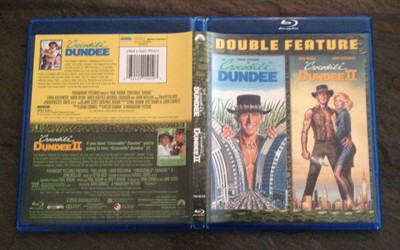 | 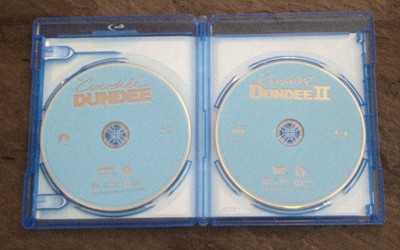 |
Things start out positively for this Crocodile Dundee Double Feature Blu-ray, as Paramount Home Video have presented each film on its own individual Blu-ray disc, giving them ample space for their audiovisual requirements. Both discs are, as now customary from the studio, blue-topped with only the titles adorning them. Thankfully, the cover artwork doesn't try anything fancy with the design, simply putting each of the classic poster designs from both films on each side, with a crocodile skin texture as a background.
Video and Audio:
In so many words? ... eh. The Crocodile Dundee films range from shrug-worthy to disappointing on Blu-ray, both framed in their original 2.35:1 aspect ratios for their 1080p AVC presentations. These have the appearance of older, touched-up transfers: dust and debris are easy to spot across both, film grain appears heavy and unnatural due to some noise reduction, and scenes with impressive fine detail and natural depth are in short supply. The first film has its moments during close-ups and daylight sequences, like the one where Mick controls the steer blocking the road and others involving the translucency of water and sun-baked skin tones, and a few outdoor sequences in New York respond well to the shaded lighting of the streets and details in motion. At other times, however, the transfer is burdened by darkness during just about all nighttime sequences, restraining details that might have made their way to the surface. Crocodile Dundee's transfer has plenty of issues, but the good barely outweighs the bad the first time around.
If you're expecting the sporadic issues present in the first film's transfer to somehow improve with Crocodile Dundee II, given that it's a few years younger and a slightly higher budget, I'd lower those expectations. While the print doesn't appear quite as unnatural, film grain is still bulky and unsympathetic to fine details, and the speckles and print damage are even more frequent than the first. What's more, the sequel also sports some noticeable edge halos in brighter sequences (check out Sue's green robe and around Mick's hat brim outdoors). Thankfully, the print itself isn't weighed down by the same issues with darkness as the first film, though certain black levels are still a bit wonky, either too light and grainy or too dark and crushing on details. Skin tones are warm and responsive to light, moderate fine details can be spotted in Mick's croc-skin jacket and in exotic landscapes, and some blasts of late-'80s color -- silky green, rich purple, reddish-orange -- are rather solid. It's unfortunate that these weren't handled better, but there are some bright spots to admire once the frustration subsides.
Both the Master Audio treatments -- a 2.0 stereo design for Crocodile Dundee, and a 5.1 surround treatment for Crocodile Dundee II -- manage the dialogue and atmosphere of the films well enough, though not really indicative of high-definition sound treatments in their blunt delivery. It's a mixed bag in the first film, really, but it's largely satisfying: the sounds of cracking fires and flapping of bird wings, subtle and natural knife blade sounds, and the bustle of dining rooms showcase some delicateness, while more robust effects (notably during a certain croc-attack sequences) can be harsh and unpleasant. The dialogue rarely has any issues with audibility, and often amply uses the mid-range and bass levels. Dundee II fairs better, of course, with richer separation in the front channels, cleaner dialogue, and more vigorous percussion-laced music, while carrying roughly the same degree of clarity with sound effects and dialogue. Both tracks suitably match their visual counterparts, even if their age holds them back in certain areas. French, Spanish, and Portuguese audio options are also available for both films, along with English, English SDH, French, Spanish, and Portuguese subtitles.
Special Features:
Not a whole lot going on here for this unceremonious Blu-ray. Aside from Trailers for the first film (2:40, HD) and the second film (1:55, HD), Crocodile Dundee II arrives with a brief Behind-the-Scenes Featurette (5:25, 4x3 SD), a vintage piece featuring quick interviews with Paul Hogan Linda Kozlowski dropped in with clips from the film. A new retrospective with Hogan, Kozlowski, and the directors would've been a nice addition, but I suppose it wasn't in the cards.
Final Thoughts:
Paul Hogan struck gold, more financially than creatively, when he dreamed up Crocodile Dundee: at a time when Australian stereotypes hadn't really expanded and been embellished on a global scale, the actor filtered the rough-and-tumble "bushman" (and the experiences of one from real-life) through his brand of humor and the damsel-defending adventurer style of story. The formula comes together into a predictable but charming fish-outta-water film in the first Crocodile Dundee, a consistently amusing comedic drama that plays with the region's carefree, hospitable attitude and almost-mythical renegades that wander the Outback. As with many box-office smashes (over $300 million for a movie that cost ~$9 million to make), it spawned a sequel that, despite being financially successful itself, ends up being a bloated dud of a follow-up that simply tries too hard ... yet still remains watchable due to Hogan's inherent charisma and his chemistry with Linda Kozlowski. Both films are presented here from Paramount on Blu-ray, and the results aren't exactly deserving of much enthusiasm, delivering barely-mediocre (if a bit lower a times) visual transfers and nearly no special features. Rent It, or just stick with the DVDs.
|
| Popular Reviews |
| Sponsored Links |
|
|
| Sponsored Links |
|
|
| Release List | Reviews | Shop | Newsletter | Forum | DVD Giveaways | Blu-Ray | Advertise |
|
Copyright 2024 DVDTalk.com All Rights Reserved. Legal Info, Privacy Policy, Terms of Use,
Manage Preferences,
Your Privacy Choices | |||||||












